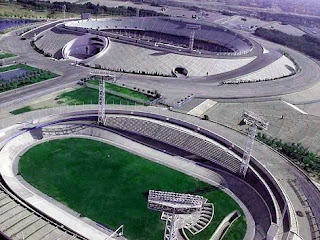1. International Stadium Yokohama, Yokohama, Jepang

From the name, you might think Iran is not an ideal place for honeymooners, but this country has many beautiful places, including a stadium that can accommodate 100,000 spectators. The stadium had been used for 1974 Asian Games

3. Stadio Olimpico, Rome, Italia
Italy had twice host the World Cup. First, in 1934, the World Cup was held at the Stadio Del PFN, and the second, namely the 1990 World Cup final in this stadium. The stadium was also witness to the history of the failure of teams AS Roma won prestige through finalti against Liverpool in 1984. In June 2001, millions of billions of dollars injected to renovate the stadium.

4. San Siro, Milan, Italia
In Italy, people can not separate the San Siro from football. Home teams Inter Milan and AC Milan, is one of the few places in Italy for sports. The stadium has a capacity of 80,000 seats with an incredible arrangement of beautiful light. There are VIP lounges and bars local fans.

5. Maracana, Rio De Janeiro, Brazil



Everyone seems menyuaki Brazilian football. No wonder when the local parliament to make the stadium with a capacity of 125,000 seats this. unfortunately, the place and even then still seems to be expanded. The stadium is purposely built for the purpose of this 1950 World Cup, to accommodate 200,000 fans overwhelmed the two teams that competed at the 1950 World Cup there. This historic stadium to spend U.S. $ 40 million for renovation costs.

6. Louis II, Monte Carlo, Monaco
The stadium question is a new version of the Louis II Stadium, which was built in 1937. The stadium is a stadium relocation itersebut, and inaugurated in 1985. The stadium which has a distinctive architecture of this Monaco, has a seating capacity for 200,000 people, and is one of the most comfortable stadium in Europe.

7. Estadio Santiago Bernabeu, Madrid, Spanyol
Real Madrid is one of the oldest football teams in Europe. Although already established since 1902, but Real Madrid have not had a "cage" itself until finally born Chamartin Stadium 1924. Unfortunately, Chamartin destroyed during the Spanish civil war, and the local government then set up the Santiago Bernabeu on the land in 1947. The stadium is a place to hold the 1982 World Cup finals. Now, the stadium is being modified and the expected completion in 2005. Renovations carried out on a large scale, but will not reduce the uniqueness and history that have been made.

8.Gelora Bung Karno,Jakarta,indonesia
Bung Karno Main Stadium is a multipurpose stadium in Jakarta, Indonesia Bung Karno Sports Arena. The stadium is commonly used as an arena football game at the international level. The stadium is named in honor of Sukarno, Indonesia's first president, who is also a figure who sparked the idea of the construction of this sports complex. In order to de-Soekarnoisasi, the New Order era, the name was changed to the stadium that is part of the Stadium Utama Senayan sports complex. After the passing wave of reform in 1998, the name of the stadium was restored to its original name through a Presidential Decree. 7 / 2001.
With a capacity of about 100,000 people, the stadium that was built in the mid-1958 and its first phase completion in the third quarter of 1962 is one of the largest in the world. Asia Cup 2007, made renovations to the stadium to reduce the stadium capacity to 88,083 spectators.
Its construction was funded with soft loans from the Soviet Union was 12.5 million U.S. dollars a certainty obtained on December 23, 1958. And of course with substantial funds that it makes this sport galanggang as the largest football stadium in Indonesia.Hingga today, Bung Karno stadium is the only truly international standard in Indonesia.

With a capacity of about 100,000 people, the stadium that was built in the mid-1958 and its first phase completion in the third quarter of 1962 is one of the largest in the world. Asia Cup 2007, made renovations to the stadium to reduce the stadium capacity to 88,083 spectators.
Its construction was funded with soft loans from the Soviet Union was 12.5 million U.S. dollars a certainty obtained on December 23, 1958. And of course with substantial funds that it makes this sport galanggang as the largest football stadium in Indonesia.Hingga today, Bung Karno stadium is the only truly international standard in Indonesia.

0 comments:
Post a Comment